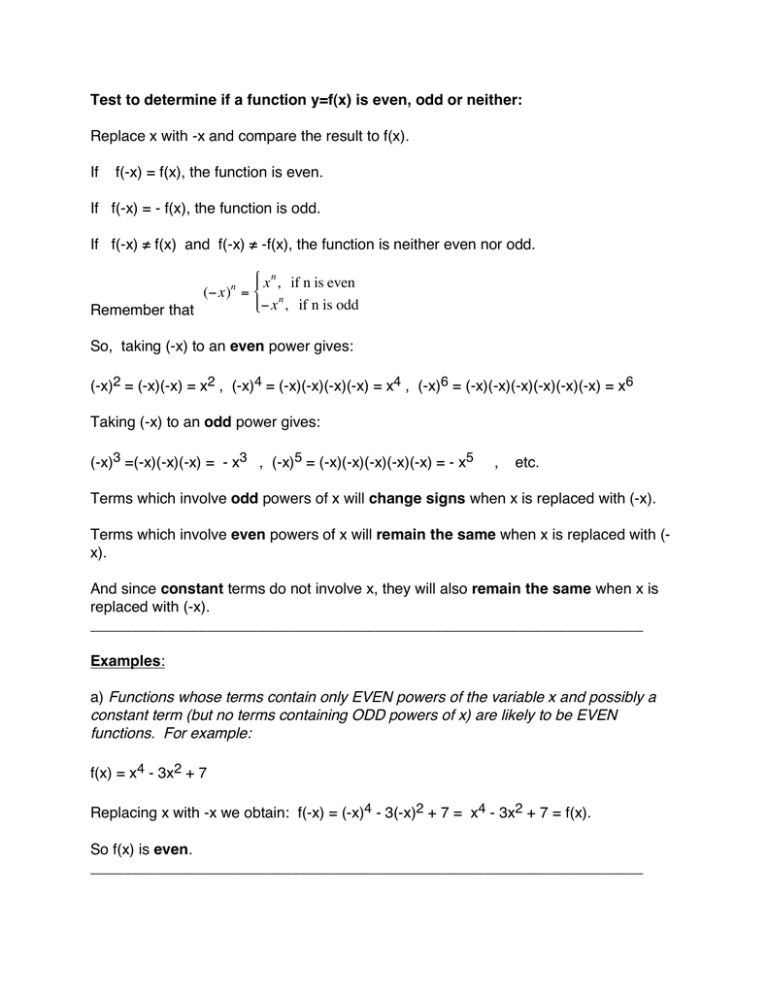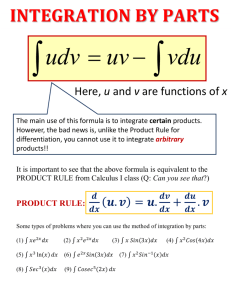Test to determine if a function y=f(x) is even, odd or neither: Replace
advertisement

Test to determine if a function y=f(x) is even, odd or neither: Replace x with -x and compare the result to f(x). If f(-x) = f(x), the function is even. If f(-x) = - f(x), the function is odd. If f(-x) ≠ f(x) and f(-x) ≠ -f(x), the function is neither even nor odd. "$ x n , if n is even (! x) = # n %$! x , if n is odd Remember that n So, taking (-x) to an even power gives: (-x)2 = (-x)(-x) = x2 , (-x)4 = (-x)(-x)(-x)(-x) = x4 , (-x)6 = (-x)(-x)(-x)(-x)(-x)(-x) = x6 Taking (-x) to an odd power gives: (-x)3 =(-x)(-x)(-x) = - x3 , (-x)5 = (-x)(-x)(-x)(-x)(-x) = - x5 , etc. Terms which involve odd powers of x will change signs when x is replaced with (-x). Terms which involve even powers of x will remain the same when x is replaced with (x). And since constant terms do not involve x, they will also remain the same when x is replaced with (-x). __________________________________________________________________ Examples: a) Functions whose terms contain only EVEN powers of the variable x and possibly a constant term (but no terms containing ODD powers of x) are likely to be EVEN functions. For example: f(x) = x4 - 3x2 + 7 Replacing x with -x we obtain: f(-x) = (-x)4 - 3(-x)2 + 7 = x4 - 3x2 + 7 = f(x). So f(x) is even. __________________________________________________________________ b) Functions which contain a term with an EVEN power of x and a term with an ODD power of x or, at least one term with an ODD power of x and a constant term are likely to be NEITHER even nor odd. . For example: f(x) = x5 - 3x3 + 7 Replacing x with -x we obtain: f(-x) = (-x)5 - 3(-x)3 + 7 = -x5 + 3x3 + 7 . Notice that the first two terms in f(x) changed signs when x was replaced with (-x), but the third (constant) term did not . So the resulting f(-x) is not equal to f(x) or -f(x). And f(x) is neither even nor odd. __________________________________________________________________ c) Functions which contain only terms with ODD powers of x ( no terms with EVEN powers of x and no CONSTANT terms) are likely to be ODD. Also, rational functions whose numerator is an ODD function and denominator is an EVEN function (or vice versa) are likely to be ODD functions. . For example: f (x) = x2 + 4 x3 ! x . Replacing x with -x we obtain: f (! x) = So f(x) is odd. (!x) 2 + 4 x2 + 4 x2 + 4 x2 + 4 = = = ! (! x)3 ! (!x) ! x 3 + x !(x 3 ! x) x 3 ! x = - f(x)

![ )] (](http://s2.studylib.net/store/data/010418727_1-2ddbdc186ff9d2c5fc7c7eee22be7791-300x300.png)


